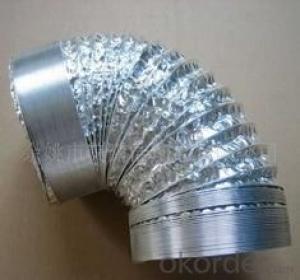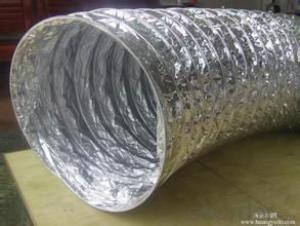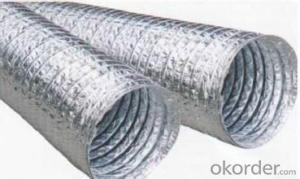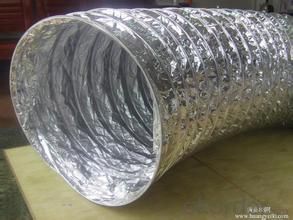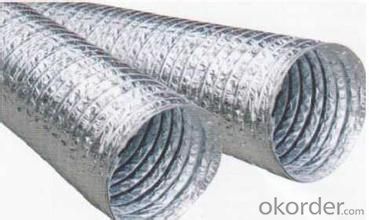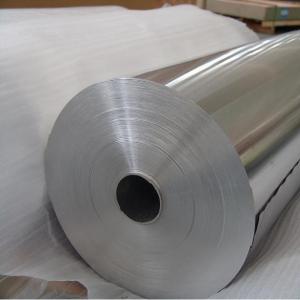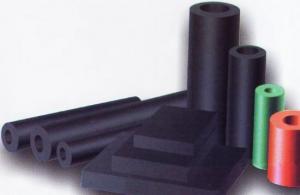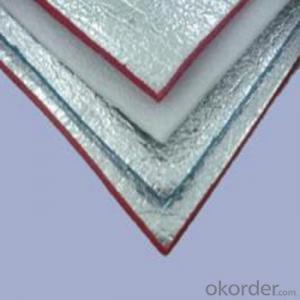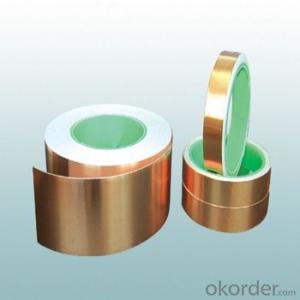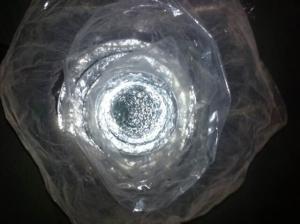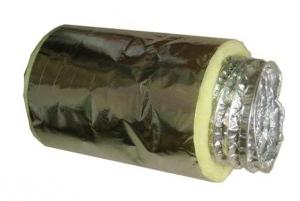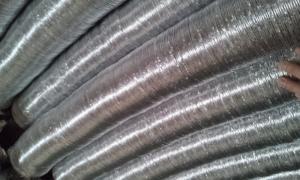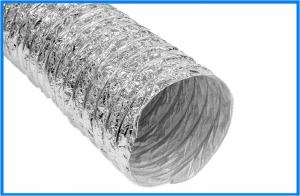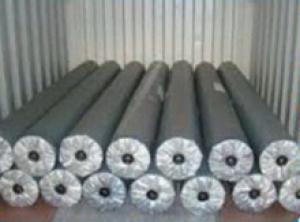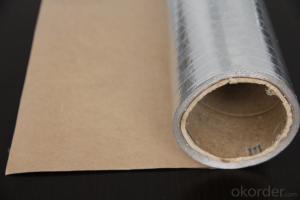Aluminum Foil Facing Uninsulated Insulated Flexible Duct in Good Quality
- Loading Port:
- Shanghai
- Payment Terms:
- TT or LC
- Min Order Qty:
- 500 pc
- Supply Capability:
- 50000 pc/month
OKorder Service Pledge
OKorder Financial Service
You Might Also Like
Features and Characters:
-Applied in Heating, Ventilation and Air Conditioning
-Non-insulated and insulated Flexible Duct offered
-Up to 150℃ and 250℃ high temperature
-Fire Retardant
-Corrosion Resistant
-High flexibility
-Convenient installation
-Non- toxic
Introduction
Flexible Duct is widely used in Heating, Ventilation and Air Conditioning (HVAC) systems for air ventilation applications. Flexible Duct provides greater thermal efficiency to save energy. The product is also covered in a heavy duty, silver jacket for durability. The vapor barrier prevents condensation forming on the outside of ducts carrying air. Because it is flexible, it is easy to run around and through obstacles in the building.
Non-insulated Flexible Duct
Structure: Two-layer aluminum foils +1 layer of PET film.
Non-insulated Flexible Duct | |
Diameter | 80-1200mm(3''-48'') |
Temperature Range | -30℃~ +250℃ |
Velocity of Airflow (Max.) | 30m/s |
Working Pressure | 2500/Pa |
Bending Radius | 0.54*D |
Fire-retardant Grade | S1 |
Standard Length | 10m or 7.6m |
Non-insulated Flexible Duct | |
Diameter | 80-1200mm(3''-48'') |
Temperature Range | -30℃~ +150℃ |
Velocity of Airflow(Max.) | 30m/s |
Working Pressure | 2500/Pa |
Bending Radius | 0.54*D |
Fire-retardant Grade | S1 |
Standard Length | 10m or 7.6m |
Insulated Flexible Duct
Structure: 1 layer of Alu. Foil+1 layer PET film+ glass wool
Outer jacket: 1 layer of Alu.foil
Glass Wool Density: 16kg/m3; Thickness: 25mm
Insulated Flexible Duct | |
Diameter | 80-1200mm(3''-48'') |
Temperature Range | -30℃~ +250℃ |
Velocity of Airflow(Max.) | 30m/s |
Working Pressure | 2500/Pa |
Bending Radius | 0.54*D |
Fire-retardant Grade | S1 |
Standard Length | 10m or 7.6m |
Insulated Flexible Duct | |
Diameter | 80-1200mm(3''-48'') |
Temperature Range | -30℃~ +150℃ |
Velocity of Airflow(Max.) | 30m/s |
Working Pressure | 2500/Pa |
Bending Radius | 0.54*D |
Fire-retardant Grade | S1 |
Standard Length | 10m or 7.6m |
- Q: What distinguishes various grades of aluminum foil sheets from one another?
- <p>Different grades of aluminum foil sheets are distinguished by their thickness, strength, and purity. Grade 1 is the purest and softest, used for food wrapping and baking. Grade 2 is harder and more tear-resistant, suitable for heavy-duty use like grilling. Grade 3 is an alloy and offers high strength and durability, often used in industrial applications. Grade 4 is a heat-treatable alloy, providing high strength and used in aerospace and automotive industries. Each grade has specific applications based on its unique properties.</p>
- Q: Is it safe to use aluminum foil as a facing material for making soups or stews?
- <p>Yes, you can use aluminum foil facing to make soup or stew. Aluminum foil is a common material used in cooking and is safe for contact with food at normal cooking temperatures. It is often used to cover pots to retain heat and moisture, or to create packets for cooking food directly on the heat source. However, it's important to ensure that the foil does not tear or come into direct contact with the heat source, as this could cause it to burn and potentially release aluminum into the food. Always follow safety guidelines and use foil responsibly in cooking.</p>
- Q: This question asks for methods to prevent aluminum from aluminum foil leaching into food.
- <p>To avoid aluminum from aluminum foil leaching into your food, use the foil sparingly and avoid wrapping food directly in it. Opt for heavy-duty aluminum foil, which is less likely to tear and expose food to aluminum. When cooking acidic or salty foods, consider using parchment paper or silicone baking mats as alternatives. Additionally, avoid using aluminum foil at high temperatures, as this can increase the risk of aluminum transfer. Finally, store food in glass or stainless steel containers instead of aluminum foil to minimize exposure.</p>
- Q: What are the potential health hazards linked to cooking with aluminum foil?
- <p>Cooking with aluminum foil is generally considered safe, but there are some potential health risks. Aluminum can leach into food, especially when it comes into contact with acidic or salty foods at high temperatures. This could lead to increased aluminum intake, which has been linked to neurological disorders like Alzheimer's disease, although more research is needed to establish a definitive link. Additionally, aluminum foil can cause burns or injuries if not handled properly. It's important to use foil responsibly, avoiding direct contact with food when possible, and to follow proper food safety guidelines.</p>
- Q: This question asks if there are any potential issues or risks associated with storing food in plastic containers for extended periods.
- <p>Yes, there are concerns about using plastic containers for long-term food storage. Certain plastics can leach chemicals, such as BPA (Bisphenol A) and phthalates, which may be harmful when ingested over time. These chemicals can migrate into the food, especially with exposure to heat or over extended periods. Additionally, plastic containers can break down over time, potentially releasing harmful substances into the food. It's recommended to use food-grade, BPA-free plastics or alternatives like glass containers for long-term storage to minimize health risks.</p>
- Q: Explain the distinction between aluminum foil insulation with and without a vapor barrier.
- <p>Aluminum foil insulation with a vapor barrier is designed to prevent moisture from passing through, which is crucial in humid environments to prevent condensation and mold growth. The vapor barrier is a layer that acts as a moisture control, enhancing the insulation's effectiveness. On the other hand, aluminum foil without a vapor barrier does not have this moisture-resistant layer, making it less effective in controlling moisture and potentially leading to condensation issues. The presence of a vapor barrier can also impact the thermal performance and energy efficiency of the insulation.</p>
- Q: What is the most suitable material for food packaging that ensures safety and is also eco-friendly?
- <p>The best material for food packaging that is both safe and environmentally friendly is biodegradable or compostable material. Materials such as PLA (Polylactic Acid), made from renewable resources like corn starch, and paper-based packaging are preferred. They are non-toxic, compostable, and reduce plastic waste. Additionally, materials like glass and metal can be recycled and are also considered safe for food contact. However, it's crucial to consider the entire lifecycle of the packaging to ensure it's truly sustainable.</p>
- Q: What are the most suitable materials for covering food to ensure safety and freshness?
- <p>The best materials for food covers include food-grade silicone, beeswax wraps, and BPA-free plastic. Food-grade silicone is durable, heat-resistant, and can be reused. Beeswax wraps are eco-friendly, reusable, and can be used in the fridge or freezer. BPA-free plastic wraps are commonly used and are good for single use, but ensure they are microwave-safe if you plan to reheat food. Always check for food safety certifications and avoid materials that can leach harmful chemicals into your food.</p>
- Q: Can aluminum foil be used as a material to create a pot holder?
- <p>Yes, aluminum foil can be used to make a pot holder. It's a versatile material that can withstand high temperatures, making it suitable for this purpose. Simply cut a piece of aluminum foil to the desired size, fold it in half, and use it to protect your hands from heat when handling pots and pans. However, for repeated use or a more durable solution, consider using heat-resistant materials like silicone or fabric specifically designed for pot holders.</p>
- Q: This question asks for the proper cleaning method for aluminum foil facing after it has been used.
- <p>To clean aluminum foil facing after use, first let it cool down to avoid burns. Then, gently scrape off any food residue with a plastic scraper or the edge of a credit card. Avoid using metal scrapers as they can scratch the surface. Wipe the surface with a damp cloth and mild dish soap to remove any grease or grime. Rinse with warm water and dry thoroughly. For stubborn stains, you can use a mixture of baking soda and water to create a paste, apply it to the stain, let it sit for a few minutes, then scrub gently and rinse. Always check the manufacturer's instructions for any specific care requirements.</p>
Send your message to us
Aluminum Foil Facing Uninsulated Insulated Flexible Duct in Good Quality
- Loading Port:
- Shanghai
- Payment Terms:
- TT or LC
- Min Order Qty:
- 500 pc
- Supply Capability:
- 50000 pc/month
OKorder Service Pledge
OKorder Financial Service
Similar products
Hot products
Hot Searches
Related keywords
